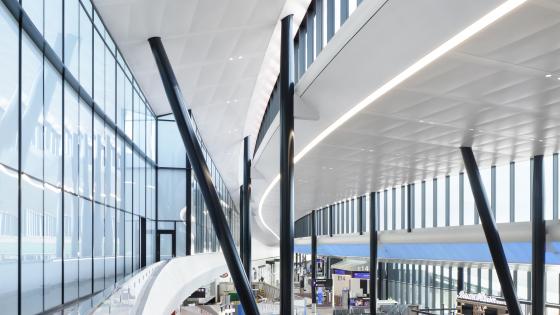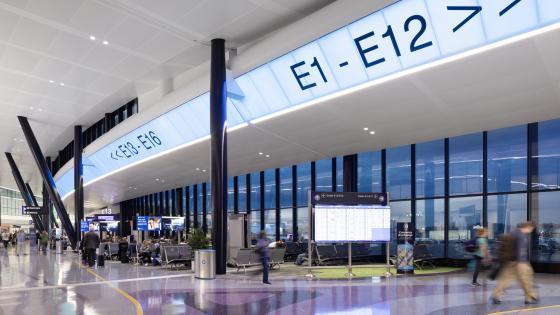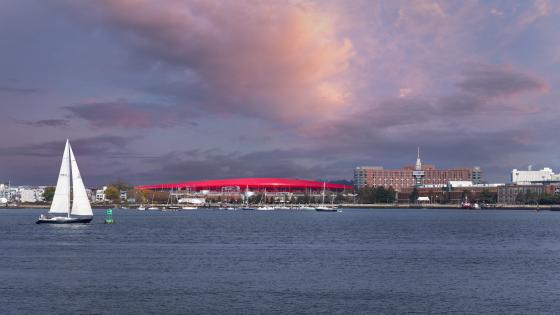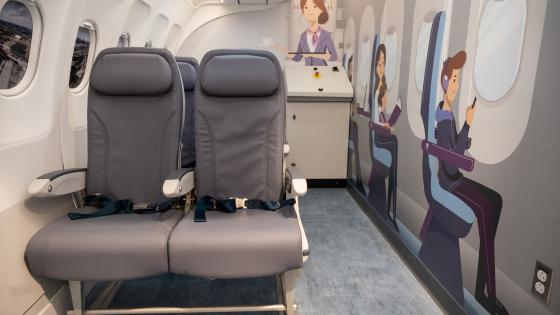Tara Craig looks at the recent expansion readying a thriving Massachusetts hub for the coming decades
Boston Logan International Airport (BOS) has changed almost beyond recognition in the near century since its first commercial flight, when, in 1927, Colonial Air Transport flew six passengers to New York. Within two decades the airport was serving European destinations, with a dedicated 12-gate international terminal opening in 1974. Fast-forward to 2019, and the airport was already bursting at the seams. Work began that spring on an expansion of Terminal E.
The result [of the expansion] is a bold, striking building designed with sustainable principles
The project was completed in autumn 2023, and while there is no denying the impact of the COVID-19 pandemic, it would seem that airport operator The Massachusetts Port Authority (Massport) made the right decision when it opted to push ahead with the expansion. Figures released in October by Massport show a year-on-year increase of 10.8% in domestic passengers using BOS for the period January to September 2023. Meanwhile, international passenger numbers rose by 34.5% over the same period, to 6,469,369. According to the operator, international travellers to Massachusetts in 2019 spent $4bn and contributed $250m in state and local taxes, figures that are expected to rise as the global resumption of international travel picks up pace. The Terminal E expansion clearly could not be more timely.

The expanded terminal is drenched in natural light thanks to its high ceilings
The project
AECOM served as the prime consultant and architect, delivering full architectural and engineering services, in collaboration with luis vidal + architects. Suffolk Construction provided pre-building and building management services. Carried out with little to no impact on everyday operations, the project saw some 390,000 sq ft being added to the existing structure, creating space for four new gates and associated amenities. The arrivals level kerb and ticketing area were expanded, and the building now offers more than 100,000 sq ft of modern hold room and concession space.
“Boston is one of the most elegant and welcoming cities in the world,” said Luis Vidal, president and founding partner of luis vidal + architects. “It was important to our entire design team that these words become part of the DNA of the new Terminal E. The result is a bold, striking building designed with sustainable principles and focused on providing a unique, comfortable and healthy environment for passengers and workers alike.”
The terminal features a dramatic swooping red roof that reveals panoramic views of downtown Boston and the city’s skyline. But it is indoors where the real transformation has taken place. According to Samantha Decker, assistant director of media relations at Massport, the expanded terminal is not only a better space, drenched in natural light thanks to its high ceilings, but delivers “a more efficient travel experience for passengers.” At the heart of this improved experience is the deployment of cutting-edge airport tech, ranging from baggage handling systems to security scanners.

The expansion gave Boston Logan the space it needed for four new gates
Improved security processes
BOS now boasts no fewer than five computed tomography (CT) security scanners, with more on the way. At the time of writing, there were two each in Terminals B and C and one in Terminal E. However, by January 2024, the new E3 Checkpoint will have five new Analogic CT lanes and the E2 Checkpoint will feature four more; Terminal E will ultimately have 11 lanes. The new scanners create 3D images that can be rotated 360° for thorough visual image analysis by a TSA officer, Decker explained. Enhanced imaging capabilities mean travellers will enjoy the added benefit of keeping electronic devices in their carry-on bags during screening. Once through the new security facilities, they will find themselves in a bright space featuring a number of new concessions, lounges and airline clubs.
Building a better BOS
The baggage handling work on the Terminal E Modernisation Project was completed by Suffolk and its subcontractor, The Jervis Webb Co, a subsidiary of Daifuku. Baggage system improvements included a number of key elements, among them the reconfiguration of the ticket counter belts feeding the West Checked Baggage Inspection System (CBIS), construction of a new outbound bag room and expansion of the baggage claim area.
The new carousels in Customs, the arrivals hall and in the new outbound bag room will facilitate the efficient processing of inbound and outbound baggage as the Terminal E volume expands, according to Massport. The work upstream of the CBIS introduces ‘round robin’ distribution to the screening equipment to allow any bag to go to any machine. This will dramatically improve the throughput of the system in instances where a piece of the explosive detection system is out of service for any reason, Decker said.
A greener future
As with any major construction project, the Terminal E expansion paid particular attention to the environment. The HVAC system was upgraded, helping improve overall energy efficiency, while steps were taken to reduce energy consumption. Decker told Airports International that Terminal E “will achieve energy efficiencies at a minimum of 20% better than the Massachusetts Building Energy Code. The project integrates several innovative environmental features, including photovoltaic window glazing, glare controlling View glass and an energy efficient displacement ventilation system.”
Water conservation is also a priority. In its application for LEED Gold certification for Terminal 4, Massport reported that the new building has seen an indoor water use reduction of 30.6% and an outdoor water use reduction of 41% compared to baseline. Indoor water usage was improved through the installation of low-flow fixtures to sinks, toilets and showerheads throughout the building. Outdoors, Massport opted for drought-tolerant planting and ground covers with native and adapted species, requiring limited or no irrigation. Native species planted in the grounds of Terminal E include Fragrant Sumac, Little Bluestem and Creeping Juniper. Less colourful, but potentially more impactful, the new gates are all-electric, with infrastructure that supports airlines’ electrical ground service equipment.

Prismatic red roof panels make the Terminal E expansion a distinctive addition to the Boston skyline
“Modernising Terminal E represents Massport’s strong commitment to strengthening our role as an economic engine and connecting the people and businesses of New England to the world,” said Massport board chair Patricia Jacobs. “These improvements to Logan create a more efficient, enjoyable travel experience for our passengers today and into the future.”
The Terminal E Expansion was financed by Massport’s Capital Plan and federal funding, including a grant of $50m for upgrading existing infrastructure from the Bipartisan Infrastructure Grant Airport Terminal Program. Asked about future expansion, Massport’s Samantha Decker told Airports International: “We’ll evaluate where demand is for international travel, what the airlines need, and then determine a plan to add the three additional gates originally planned for that have been permitted back into our capital programme.”

The cabin element of Terminal E’s sensory room has been designed to help those who find flying stressful
Further reading: an airport for all
The modernisation programme at Boston Logan responds to diverse passenger needs by providing various amenities within the Departures level, including a mothers’ room and sensory room. The addition of the sensory room makes Boston Logan one of the few major airports in the US to provide this type of facility to passengers of all ages, with various interactive stations that focus on balance, light therapy and cognitive/memory improvement, including a room that replicates an airplane cabin to help passengers acclimate themselves with the often-stressful experience of flying. This initiative is a continuation of Massport’s efforts towards creating more inclusive spaces for travellers.
